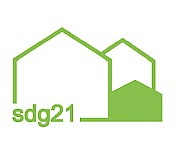Apply now!
Climate-active municipalities and regions wanted! The "Municipal Climate Protection" competition, which has been running since 2009, is now called the "Climate Active Municipality" competition and will run from January to the end of March 2016.
© Difu /Anna Jolk
The new name of the nationwide competition emphasises the comprehensive commitment of local authorities to tackling climate change. We are looking for cities, municipalities and districts as well as regions in which topics such as climate-friendly construction and renovation, climate adaptation, climate-friendly mobility, sufficiency or transnational climate activities play a role. We are looking for successfully realised and effective climate projects.
The competition
Together with the Federal Ministry for the Environment, the German Institute of Urban Affairs (Difu) organises the annual "Climate Active Municipality" competition (until 2015 the "Municipal Climate Protection" competition). Co-operation partners: German Association of Cities, German Association of Counties and German Association of Towns and Municipalities.
Application deadline: From January to 31 March 2016 municipalities and regions can apply. Competition participants from previous years are also welcome to take part again - especially if their projects have progressed further in the meantime. The necessary application documents can be downloaded at the bottom of this page.
The award
The nationwide competition gives municipalities and regions the opportunity to present their successfully realised climate projects to a broad public and serve as a good example for others. To this end, we support the winners in publicising their award-winning projects. Among other things, the winning projects are presented as a film and in a competition documentary. The winners of the "Climate Active Municipality 2016" competition will be presented at the Municipal conferencewhich was published on 28 and 29 November 2016 in Berlin will be publicly announced and awarded prizes.
The prize money
The winning municipalities will receive prize money of 25,000 euros each. The winners must reinvest the prize money in projects that serve to protect the climate or adapt to climate change and will be asked to name the measures before the award ceremony. In this way, the award does not mark the end of the activities, but is also the starting signal and motivation for continuing, optimising and for new activities. How the prize money from previous years was used.
The jury is made up of the Federal Ministry for the Environment, Nature Conservation, Building and Nuclear Safety, the Federal Environment Agency, the German Association of Cities, the German Association of Districts and the German Association of Towns and Municipalities.
The application documents
The necessary application documents can be downloaded at the bottom of this page. There is a special application form for each category, which must be completed and submitted together with a detailed project description (see page 4 of each form). Multiple applications are possible. Please use a separate application form for each application. Please send your application documents by post or e-mail to: German Institute of Urban Affairs, Auf dem Hunnenrücken 3, 50668 Cologne, e-mail: klimaschutz@difu.de. Legal recourse is excluded.
The competition team will be happy to answer any questions you may have about the competition:
Telephone: 0221/340 308-12, e-mail: klimaschutz@difu.de
Answers to frequently asked questions about the 2016 competition can be found here...
- Competition flyer "Climate Active Municipality 2016" (barrier-free) PDF | 3 MB
- Competition flyer "Climate Active Municipality 2016" (print version) PDF | 4 MB
- Key visual competition 2016 ZIP | 3 MB
- Application form category 1 PDF | 2 MB
- Application form category 2 PDF | 2 MB
- Application form category 3 PDF | 2 MB
Keywords:
DE-News, Funding, Climate protection
In its August issue, ÖKO-TEST magazine evaluated 15 different roof insulation materials, including 5 with the natureplus seal of approval. The products are mainly suitable for insulation between rafters. The good performance of conventional products made of glass and rock wool, which all achieved "good", was striking. Of the natureplus-certified products, 2 insulation materials made of wood fibres - "Gutex Thermoflex" and "Pavaflex" by Pavatex - achieved the best rating in the test with "very good", while other products only scored "satisfactory" ("Isocell" cellulose fibre, "Thermo-Jute" by Thermo Natur) or "sufficient" (Ziro "Corktherm 040").

